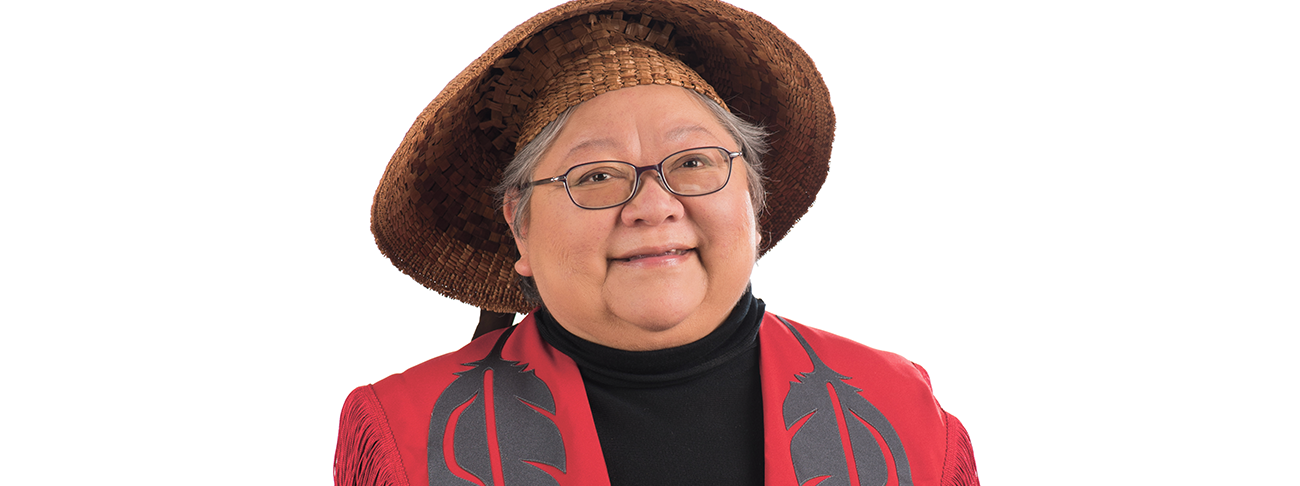
Lorna Wanosts’a7 Williams is a member of the Lil’wat First Nation of Mount Currie, British Columbia. She led the development of Bachelor’s and Master’s degrees in Indigenous Language Revitalization, and a Master’s in Counselling in Indigenous Communities at the University of Victoria, where she is Professor Emerita of Indigenous Education, Curriculum and Instruction. She also developed a mandatory course in Indigenous Education for all teacher education students in British Columbia. Williams received the Order of Canada in December 2020. She will lead a keynote conversation during the upcoming October 15 CAUT Indigenizing the Academy event.
How do you define Indigenization?
Indigenization is when we’re able to embed Indigenous points of view and ways of being within our practice in institutions and in society. When we can be who we are, and it’s understood and recognized either in public or within institutions.
What contributes to recent gains for Indigenization?
The growing visibility of Indigenous people in the country. Part of the colonial practice was to make Indigenous people invisible, not visible in society, or visible only in a very particular way, usually in a demeaning and dehumanizing way. That has been changing. There are more Canadians that are educating themselves about Indigenous people, and the younger population is much more open to that education than the older generation.
How do you view the appointment of Mary Simon as Canada’s first Inuk Governor General?
Mary Simon was nominated once before and wasn’t selected. For her to be considered again, then to be accepted, and for her to accept the role, increases the visibility, and accelerates change in the way Indigenous people are viewed.
I think Canadians are finally open to hearing their history in another way. The identification of unmarked graves, close to residential schools, has certainly been in the media, and emerged as a topic of active discussion.
The United Nations has also increased the visibility of Indigenous people by declaring 2019 the Year of Indigenous Languages. That year, the Indigenous Languages Act was finally accepted in Canada, with, more recently, a commissioner appointed who is Indigenous.
What role do you see for post-secondary institutions to keep Indigenous languages living?
Universities have played an active role and made a huge difference in all my work in Indigenous language revitalization. Beyond regular programs, some universities offered courses and programs for the people who are working on Indigenous languages in the communities, to learn together, learn ways of doing things, to protect and revitalize languages. Courses that are focused on Indigenous languages and Indigenous language revitalization really supported those communities.
The big problem, however, is that Indigenous languages do not have a place within the structure of higher education. The study of language, for example, even in second language learning, is often based on European and Euro-Western languages. The Indigenous perspective and languages do not fit into those models. Language revitalization also doesn’t have a place within the current structure. That must change.
Can the Indigenization of the academy have an impact on the revitalization of Indigenous languages?
It’s beginning but there are many challenges ahead. We desperately need Indigenous language teachers both within communities, in Indigenous schools, and in the public school system. But it’s a real challenge for Indigenous language teachers to become certified. They can get a degree but not the professional certification from the provinces. I conducted a research project that looked at Indigenous language teachers in British Columbia. That was the number one need across the province, both in the public system and in the First Nations band school system.
How can post-secondary institutions become open spaces for Indigenous knowledge learning?
Post-secondary institutions need to be able to actively reflect and question their foundation, which is all based on a very Western European philosophical stance on what knowledge is, and how we gain knowledge. They need to dismantle the fence they’ve put around what knowledge is and how we gain that knowledge. Right now, all other forms of knowledge are really kept outside that fence. This is a big task for institutions because it means re-defining who they are, their identity that has been established over many hundreds of years.
What gives you hope?
I hear and I see younger people, students who are active in universities, demanding a better understanding of Indigenous knowledge. That gives me hope. It’s the young people who will make the changes. When I visit universities across the country, and in many parts of the world, people are wanting to know about Indigenous knowledge.